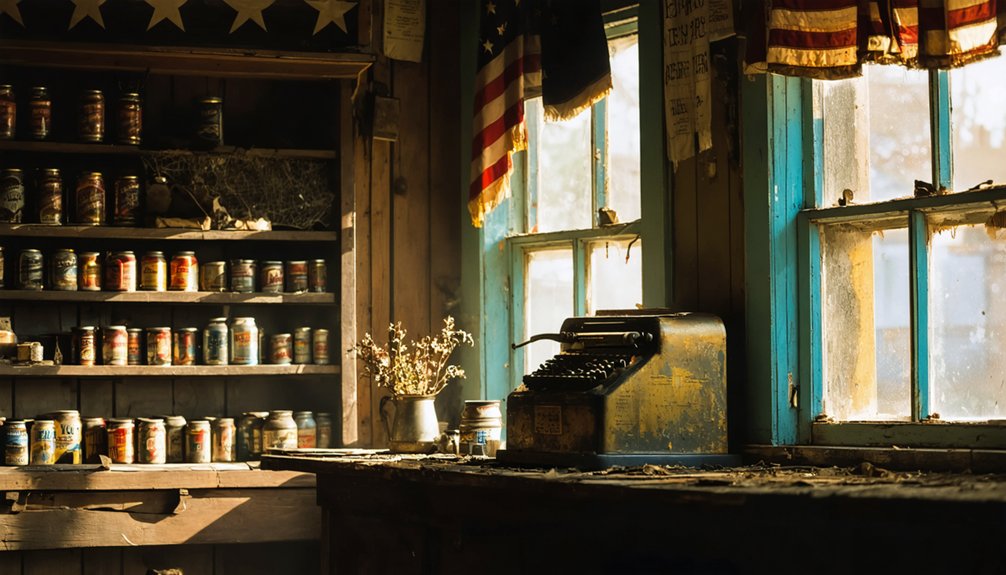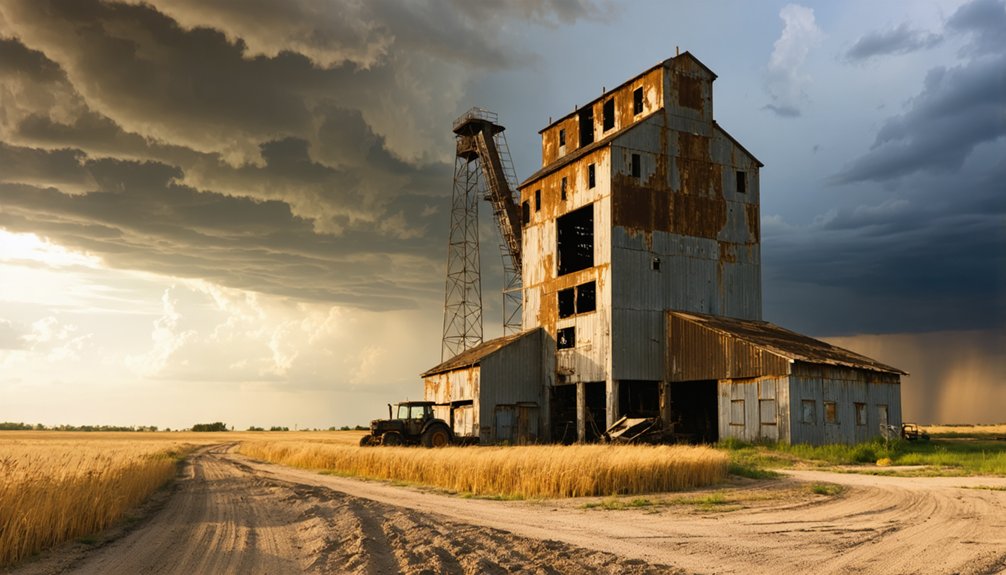Midwest ghost towns emerged during 19th-century resource booms near mines, timber, and farmland, with Wisconsin alone housing over 150 abandoned settlements. You’ll find these towns fell victim to resource depletion, economic collapse, environmental degradation, and disease outbreaks between 1880-1940. Their toxic legacies remain visible today, particularly in mining towns like Picher, Oklahoma. Local historical societies work tirelessly to preserve these haunting remnants of America’s boom-and-bust cycles. The empty streets still whisper their stories.
Key Takeaways
- Wisconsin alone contains over 150 documented ghost towns, primarily abandoned following the collapse of lead mining operations.
- Midwest ghost towns emerged during the 1880-1940 boom period but quickly declined when resources were exhausted or transportation routes changed.
- Environmental factors like prolonged drought and mining pollution rendered many Midwestern settlements uninhabitable and triggered mass exoduses.
- Mining towns like Picher, Oklahoma became toxic wastelands with dangerous levels of heavy metals and unstable ground from underground excavations.
- Preservation efforts through historical societies and adaptive reuse have transformed some abandoned settlements into museums and tourist destinations.
The Rush and Ruins: How Midwest Ghost Towns Were Born

The story of Midwest ghost towns begins with the explosive growth of settlements during the resource booms of the nineteenth century, when copper and gold discoveries in regions like Michigan’s Upper Peninsula drew thousands of enthusiastic prospectors and settlers seemingly overnight.
You’ll find these towns emerged wherever valuable resources were abundant—near mines, forests for timber, or fertile farmland. Wisconsin settlements particularly vanished when lead mining operations depleted their primary resource. These areas also reflect the complex migration patterns of various populations seeking economic opportunity throughout the region’s development.
Town development followed a predictable pattern: temporary housing appeared first, followed by essential businesses like sawmills and general stores as populations stabilized.
Communities thrived along transportation routes—rivers, canals, and especially railroads—which facilitated trade and migration.
But this prosperity rarely lasted. When mines emptied, forests disappeared, or transportation patterns shifted, resource depletion triggered rapid abandonment, leaving behind the silent shells we now call ghost towns.
From Boomtowns to Abandoned Places: What Remains Today
Walking among the skeletal remains of once-thriving communities, you’ll discover a landscape dotted with over 150 documented ghost towns across Wisconsin alone—a tribute to the boom-and-bust cycles that shaped Midwestern settlement.
Ghost town tourism has breathed new life into several abandoned places. Garnet, Montana retains approximately 30 buildings, while Bodie, California preserves 110 structures as a state historic park.
In Wisconsin, Henry Gratiot’s house stands as the state’s second-oldest home, now operating as a bed and breakfast after extensive restoration.
Historical preservation efforts highlight three distinct patterns:
- Mining towns abandoned when resources depleted
- Settlements devastated by disease or environmental catastrophe
- Communities that emptied during wartime industrial shifts
These physical remnants offer tangible connections to complex narratives of ethnic history, economic evolution, and environmental vulnerability that define Midwestern development. The period between 1880 and 1940 saw the greatest number of ghost towns emerge as westward expansion and industrialization dramatically reshaped the American landscape.
Today’s vacant properties tell a similar story, with areas like Flint, Michigan experiencing extreme housing abandonment due to economic decline that has pushed median home values as low as $44,400.
Wisconsin’s Forgotten Mining Legacy: Lead, Silver and Lost Dreams

If you travel through southwest Wisconsin today, you’ll encounter the scattered remnants of once-thriving mining communities like Gratiot’s Grove, where recent restoration efforts have preserved limestone structures dating to the 1830s Cornish mining era.
The rapid boom-to-bust cycle left numerous ghost settlements across Grant, Crawford, Iowa, and Lafayette counties, where epidemics of cholera and smallpox decimated populations already diminished by the California Gold Rush exodus.
These abandoned sites, where zinc eventually replaced depleted lead deposits, represent Wisconsin’s overlooked mineral extraction history that shaped the state’s early development and left behind a legacy of architectural curiosities amid overgrown mining pits. Early miners were nicknamed badgers because they often burrowed into hillsides for shelter rather than building proper homes. By 1829, the region’s incredible productivity yielded 13 million pounds of lead, highlighting the economic significance that drew thousands to this frontier territory.
Boom-to-Bust Mining Towns
Southern Wisconsin’s rich lead deposits sparked a mining boom in the early 1830s that would forever alter the region’s landscape and history.
These once-thriving communities witnessed meteoric rises followed by devastating collapses when resources vanished by mid-century. The mining heritage of places like Mineral Point and New Diggings represented America’s resource-driven frontier spirit.
Town survival depended on three critical factors:
- Resource sustainability (quickly exhausted by the 1860s)
- Transportation access (towns bypassed by railroads perished)
- Public health conditions (epidemics like Sinipee’s malaria outbreak decimated populations)
While southern Wisconsin faced decline, northern Wisconsin remained largely untouched by white settlers until the 1840s, when exploration for new mining opportunities began. The region’s lead mining operations contributed approximately 40 percent of the nation’s lead output during their peak in the 1840s. Environmental degradation compounded these challenges, leaving contaminated soil unsuitable for agriculture.
Today, you’ll find only ghostly remnants—cemeteries, crumbling foundations, and historical markers—where thousands once sought fortune, their boom-to-bust cycle serving as a sobering reminder of prosperity’s fragility.
Gratiot’s Grove Restoration
While many of Wisconsin’s mining settlements faded into obscurity, Gratiot’s Grove stands as a symbol to historical preservation efforts that illuminate the state’s forgotten lead mining legacy.
The sole surviving limestone Gratiot House represents more than architecture—it embodies the remarkable economic and cultural significance of a once-thriving community that peaked at 1,500 residents. Founded in the 1820s by the entrepreneurial Gratiot brothers, this settlement achieved what others couldn’t: peaceful coexistence with the Winnebago tribe through Catherine Myott’s influence. Colonel Henry Gratiot’s effective role as an intermediary for the Winnebago during the Black Hawk War helped secure the release of American hostages. Henry’s wife Susan Gratiot became renowned throughout the region as a Medicine Queen for her healing abilities during cholera outbreaks that devastated the mining communities.
When you visit this restored site, you’re witnessing the physical manifestation of Wisconsin’s industrial beginnings—where six furnaces once processed the region’s ore and where Henry Gratiot established a temporary mining monopoly while serving as an Indian agent during tumultuous frontier relations.
Disease-Ravaged Settlement Remains
As a stark contrast to Gratiot’s Grove’s preservation success, the disease-ravaged settlement of Sinipee represents the darker side of Wisconsin’s mining legacy.
You’ll find almost nothing of this once-thriving 1830s mining community—devastated by catastrophic malaria outbreaks when melting snow created ideal mosquito breeding conditions.
Mining health concerns went largely unaddressed in these frontier settlements, where:
- Disease outbreaks, particularly malaria, decimated the workforce and community
- Economic collapse followed as both population and mining yields declined simultaneously
- Environmental factors compounded the settlement’s vulnerability to abandonment
Today, only scattered grave markers and occasional historical plaques along the Mississippi River corridor testify to Sinipee’s existence.
These silent monuments reveal how quickly prosperity could vanish when natural resources, human labor, and public health collapsed in tandem.
When Nature and Economy Collide: The Environmental Factors

As you travel through the abandoned towns of the Midwest, you’ll encounter communities devastated by prolonged drought periods that depleted water sources and destroyed agricultural livelihoods.
The environmental aftermath of mining operations remains visible in scarred landscapes, contaminated waterways, and massive piles of waste rock that continue to leach toxic materials into surrounding ecosystems.
These environmental wounds, combined with economic collapse, have transformed once-thriving settlements into silent monuments to the fragile relationship between human enterprise and natural systems.
Drought Destroys Communities
Throughout the American Midwest, devastating drought cycles have repeatedly transformed thriving agricultural communities into ghost towns, revealing nature’s power to erase human settlement. When rainfall dips below 20 inches annually in semi-arid prairie regions, you’ll find community resilience pushed to its breaking point.
The Dust Bowl‘s multiple drought waves (1934-1940) triggered unprecedented migration, with over 500,000 Americans abandoning their homes.
Water shortages impact communities in three critical ways:
- Crop failures lead to mass foreclosures and economic collapse
- Topsoil erosion permanently destroys farmland viability
- Declining river levels disrupt barge transportation systems
These drought-driven abandonments leave physical scars across the landscape—submerged towns like Nebraska’s Lemoyne emerge during modern droughts, ghostly reminders of prosperity’s fragility when confronting environmental limits.
Mining Scars Remain
Mining operations that once fueled Midwestern economic prosperity have left behind a toxic legacy you’ll find etched into the landscape of numerous ghost towns today.
Places like Picher, Oklahoma—once thriving centers of lead and zinc extraction—now stand abandoned, victims of their own industrial success.
You’ll encounter massive “chat” piles containing dangerous levels of lead, cadmium, and zinc surrounding these sites. This mining pollution has penetrated soil and groundwater, creating uninhabitable zones where families once lived.
Underground excavations have left the earth unstable, threatening buildings with sudden collapse.
The environmental legacy extends beyond visible scars—altered hydrology continues to drain contaminants into watersheds decades after mining ceased.
These ghost towns represent the ultimate price of resource extraction without environmental foresight.
Mapping the Emptiness: Where to Find Midwest Ghost Towns
The Midwest’s abandoned communities dot the landscape in surprising numbers, with Michigan alone housing over 70 documented ghost towns meticulously mapped by regional explorer EagleEyeExplorer.
These hidden treasures aren’t randomly distributed—they follow patterns tied to resource depletion, particularly where logging and railroad operations once thrived.
When searching for these forgotten stories, you’ll find several thorough resources:
- EagleEyeExplorer’s Michigan Ghost Towns map provides historical context for each location
- Local historical societies maintain detailed records of abandoned settlements
- Online platforms featuring state historical markers and cemetery listings
You’ll notice naming patterns as you explore—five towns named “Wilson” and “Hopewell” exist across the region, while nearly 300 ghost towns share names with exactly one other location, reflecting the Midwest’s settlement history.
Cultural Echoes: The People Who Called These Towns Home

Behind the geographic coordinates and abandoned structures on EagleEyeExplorer’s maps exist profound human stories that illuminate Midwestern ghost towns’ true significance.
You’ll find tales of cultural resilience in these once-vibrant communities where immigrant families built lives around mining booms of the 1920s. When towns like Picher, Oklahoma swelled to 14,000 residents, tight-knit communities formed around company housing and shared hardships.
As mines closed, mass displacement scattered these communities, forcing families to abandon generational homes with little warning. Despite this trauma, forgotten traditions persisted through ethnic festivals, local dialects, and folk music.
Former residents preserved their heritage through oral histories and annual reunions. Their experiences of displacement and renewal continue to echo in regional art, literature, and museums—powerful reminders of communities that refused to vanish completely from collective memory.
Preserving the Past: Efforts to Save Midwest Ghost Town History
Across the weathered landscapes of America’s heartland, concerted preservation efforts have emerged to safeguard the physical remains and cultural legacy of Midwest ghost towns before they vanish completely.
Community engagement forms the backbone of these initiatives, with local historical societies partnering alongside government agencies to document artifacts and stabilize deteriorating structures.
Preservation funding remains the greatest challenge, with projects relying on:
- Private donations and volunteer workforces to sustain operations
- Federal grants that have injected up to $7 million into single ghost town projects
- Adaptive reuse strategies converting abandoned buildings into museums and visitor centers
You’ll find these preservation efforts not only protect physical structures but maintain connections to regional narratives demonstrating resilience and community transformation through time—telling stories that might otherwise be lost forever.
Frequently Asked Questions
Are There Supernatural Phenomena Reported in Midwest Ghost Towns?
Yes, you’ll find numerous ghost sightings and paranormal phenomena in Midwest ghost towns, documented through paranormal investigations at locations like Villisca Axe Murder House and McPike Mansion.
How Safe Is It to Explore Abandoned Midwest Ghost Towns?
As shadows stretch across forgotten streets, you’ll face significant risks. Urban exploration of ghost towns requires meticulous preparation—sturdy boots, air horns, and respect for structures that may collapse without warning.
What Items Can Visitors Legally Take From Ghost Towns?
You can’t legally take artifacts from ghost towns without permission. Souvenir ethics and preservation laws require you to leave historical items undisturbed, protecting these sites for everyone’s future exploration.
Can You Purchase Property in Midwest Ghost Towns Today?
Yes, you can purchase Midwest ghost towns today. Ghost town investments range from $250,000 to over $1 million, offering real estate opportunities with historic buildings, though zoning laws and preservation regulations apply.
Are There Seasonal Events or Tours of Midwest Ghost Towns?
You’ll find seasonal ghost tours throughout the Midwest, particularly during Halloween. Michigan’s MIPARACON offers haunted investigations, while towns like Galena provide year-round ghost tours with special Halloween-focused events and walks.
References
- https://pbswisconsin.org/news-item/southern-wisconsins-ghost-towns-leave-behind-vital-stories/
- https://www.geotab.com/ghost-towns/
- https://jrap.scholasticahq.com/api/v1/articles/9543-the-economics-of-ghost-towns.pdf
- https://247wallst.com/housing/2024/04/11/americas-modern-ghost-towns-2/
- https://www.loveexploring.com/gallerylist/188219/the-us-state-with-the-most-ghost-towns-revealed
- https://www.youtube.com/watch?v=lfj6aeZEVJY
- https://en.wikipedia.org/wiki/Lists_of_ghost_towns_in_the_United_States
- https://www.atlasobscura.com/lists/abandoned-places-midwest
- https://battlegroundhistory.com/american-midwest/
- https://www.nps.gov/slbe/learn/historyculture/ghosttowns.htm



